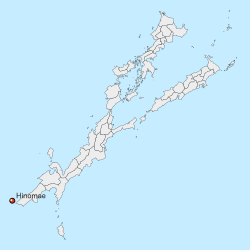Hinomae
| Hinomae 火野前 | |||
|---|---|---|---|
| Town | |||
Hinomae-machi | |||
 Iwamai Garden | |||
| |||
| Nickname(s): The place where rice grows on rocks, Rock valley | |||
 Location of Hinomae in Okaiken | |||
| Country |
| ||
| Island | Yagishima | ||
| Region | Southern Yagishima Region | ||
| Prefecture | Aomori | ||
| Founded | 1567 | ||
| Government | |||
| • Type | Civic | ||
| • Mayor | Hinatoshi Sara (I) | ||
| Area | |||
| • Total | 26.59 km2 (10 sq mi) | ||
| Population (April 1, 2017) | |||
| • Total | 503 | ||
| • Density | 19/km2 (49/sq mi) | ||
| Time zone | Okaiken Standard Time (UTC+9) | ||
| ISO 3166-2 | OKYA-12 | ||
Hinomae (火野前 Hinomae) is a town located in the Southwesternmost portion of Yagishima in Okaiken. It is the westernmost point in Okaiken. the town is sandwiched between Mt. Ryūshutsu, an dormant, steep sloped composite volcano and the Yagishima Alps. The town is known for its rare and unique species of Oryza incaensus, commonly called as the Hinomae rice tree. This species of rice is endangered but is protected under Okaiken's Species Act of 2015.
The name of the village comes from the Sanese phrase Hi no mae (火の前 Hi no mae) which means "before the fire", pointing to its geographic location near the foot of a volcano. The area near the volcano remained uninhabited until the end of the medieval period, when the samurai Michinaga Yorimichi claimed the territory as part of the kokudaka land surveying system. A small settlement of Jōdo-shu monks and followers later occupied the site. As of April 2017, the town has a population of 503.
Hinomae is known outside of Okaiken for its rice products, with the grains of Oryza incaensus being one of the most expensive and sought-after grain products in Adonia. It is also known for its festival that only happens every 12 years, where one rice tree is cut and brought up to Mt. Ryūshutsu as an offering to the Amida Buddha.
Geography[edit | edit source]
Hinomae is located in the Southwesternmost tip of the Suwa Peninsula in the island of Yagishima. The town is on the bottom of a steep valley that separates Mt. Ryūshutsu and the Southwest face of Mt. Hino. The town is also surrounded by the Sea of Mitoyagi. Looking deeper into its geological history, the area around the town used to be under the sea until 45,000BCE, when a massive explosion of Mt. Ryūshutsu filled the Eastern portion that separates the volcano to Yagishima and created the area that is now occupied by Hinomae. Today, the town is in average four metres above the sea level with the Hinomae river, an important source for the rice trees, running through the town before emptying at the northern shore of the town.
The landscape the town is situated on is riddled with giant volcanic boulders that were spewed by Mt. Ryūshutsu when it last erupted more than 2,000 years ago. Although the slopes of the valley are steep, the valley bottom has remained flat, which makes it perfectly available for rice cultivation. Its rich, fertile black soils also allowed plants to grow above its average size, with Oryza incaensus growing 50 times larger than its closest relative Oryza sativa.
Since the town is located on a remote location, it is only accessible by Route 1 of the Okaiken Highways system. The closest airport from Hinomae is located in Sekiguchi, about 98 miles from the town centre.

